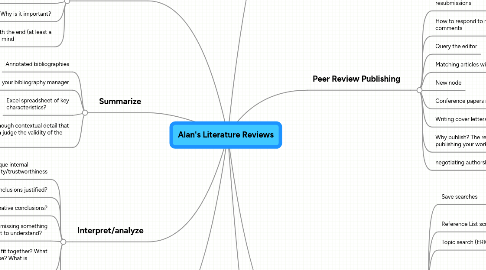Alan's Literature Reviews
by Rick West


1. Choosing Topic
1.1. Analyzing Audience
1.2. Selecting journal
1.3. Problem statement, intro lit summary
1.4. Key topics/researchers in the area
1.5. Why is it important?
1.6. begin with the end (at least a belief) in mind
2. Summarize
2.1. Annotated bibliographies
2.2. Notes in your bibliography manager
2.3. Excel spreadsheet of key characteristics?
2.4. Provide enough contextual detail that others can judge the validity of the studies.
3. Interpret/analyze
3.1. Critique internal validity/trustworthiness
3.2. Were their conclusions justified?
3.3. Could there be alternative conclusions?
3.4. Are they missing something important to understand?
3.5. How do the individual pieces fit together? What is missing in the literature base? What is overlooked?
3.6. Connect the dots between study to conceptualize overall framework
4. Write
4.1. Writing strategies, challenges, and overcoming challenges
4.2. writing groups and peer review
4.2.1. How to give effective peer critiques
4.2.2. how to receive/interpret critiques effectively
4.3. creating timelines, deadlines, and accountability
4.4. Begin writing at the beginning
4.5. Write every day--maintain momentum
4.6. Jot down reflections that come but don't make it into the draft
4.7. A time to read, and a time to write
4.8. Use the writing center!
4.9. APA helps
4.10. Common errors in writing (panel of journal reviewers?)
4.11. outline
5. New node
6. Peer Review Publishing
6.1. Acceptance, rejection, and resubmissions
6.2. How to respond to reviewer's comments
6.3. Query the editor
6.4. Matching articles with journals
6.5. New node
6.6. Conference papers as stepping stones
6.7. Writing cover letters to journal editors
6.8. Why publish? The reasons for publishing your work
6.9. negotiating authorship
7. (Search) Finding sources
7.1. Save searches
7.1.1. My EBSCO
7.1.2. Researcher Journal
7.2. Reference List scraping
7.3. Topic search (ERIC, Wilson)
7.4. Author search (Web of Science
7.4.1. read the original works
7.4.2. Critique the original works--don't simply accept them.

